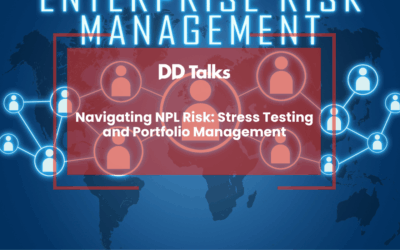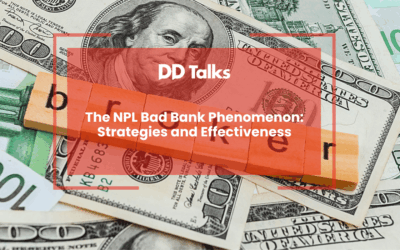Essential Insights for NPL Management Excellence
- Early intervention is critical – Proactive monitoring systems that identify deteriorating credit quality before default allow for more effective restructuring outcomes.
- Portfolio segmentation drives recovery – Advanced analytics enable tailored workout strategies based on borrower characteristics, collateral quality, and recovery potential.
- Technology transformation is non-negotiable – AI, machine learning and digital platforms are revolutionizing NPL management through predictive modeling and process automation.
- Collaborative approaches yield results – Transparent communication between lenders and borrowers creates mutually beneficial restructuring solutions aligned with actual cash flow potential.
- Special situations create value opportunities – Complex distressed scenarios like debt-to-equity conversions and strategic joint ventures can unlock significant value beyond conventional approaches.
- ESG considerations are reshaping strategies – Sustainability factors are increasingly influencing restructuring decisions and will continue to impact distressed asset management through 2025.
Table of Contents
- Understanding NPL Restructuring in Today’s Financial Landscape
- Key Drivers Behind Successful Distressed Debt Workouts
- How Can Banks Maximize NPL Recovery Rates?
- Implementing Effective Loan Workout Strategies
- Technology-Driven Approaches to NPL Portfolio Optimization
- Creating Value Through Special Situation Opportunities
- Future Trends in Distressed Asset Management for 2025
Understanding NPL Restructuring in Today’s Financial Landscape
NPL restructuring represents a critical function within European banking systems, particularly as financial institutions navigate the aftermath of economic disruptions. Non-performing loans (NPLs) are credit facilities where borrowers have failed to meet contractual payment obligations for 90 days or more, creating significant challenges for lenders’ balance sheets and capital adequacy ratios.
The current European financial landscape has witnessed a notable evolution in NPL management approaches. Rather than viewing distressed assets merely as liabilities to be offloaded, forward-thinking institutions now recognise them as potential value-creation opportunities through sophisticated restructuring techniques. This paradigm shift has been accelerated by regulatory pressures from the European Central Bank and the European Banking Authority, which have established comprehensive NPL resolution frameworks.
Effective NPL restructuring involves a multi-faceted approach that may include loan modification techniques, term extensions, interest rate adjustments, debt-to-equity conversions, or partial debt forgiveness. The ultimate objective is to transform non-performing exposures into performing assets or to maximise recovery value through strategic disposition. This process requires deep expertise in credit analysis, legal frameworks, and sector-specific knowledge to determine the optimal restructuring path for each distressed asset.
Key Drivers Behind Successful Distressed Debt Workouts
The effectiveness of distressed debt restructuring hinges on several critical factors that determine ultimate recovery outcomes. First and foremost, early intervention proves decisive in preserving asset value. Financial institutions that implement proactive monitoring systems to identify deteriorating credit quality can engage borrowers before default scenarios become entrenched, significantly improving restructuring prospects.
Another crucial driver is the quality of borrower engagement. Successful workouts typically involve transparent communication channels and collaborative approaches between lenders and borrowers. This partnership mentality facilitates more realistic assessments of borrowers’ financial capabilities and fosters mutually beneficial restructuring solutions that align repayment terms with actual cash flow potential.
Regulatory considerations also substantially influence distressed debt workouts. The European regulatory landscape has evolved considerably, with frameworks like the EU’s NPL Directive establishing standardised approaches to NPL management. Institutions that maintain robust compliance mechanisms while navigating these regulatory requirements can execute more efficient restructuring processes.
Additionally, market liquidity for distressed assets plays a pivotal role. The maturation of Europe’s secondary NPL market has created enhanced exit opportunities, with specialised distressed debt investors actively seeking acquisition targets. This expanded investor base provides banks with additional restructuring options, including portfolio sales, securitisation structures, and joint venture arrangements with experienced distressed asset managers.
How Can Banks Maximize NPL Recovery Rates?
Maximising NPL recovery rates requires a sophisticated, multi-dimensional approach that begins with accurate portfolio segmentation. European banks achieving superior recovery outcomes typically employ advanced analytics to categorise distressed assets based on borrower characteristics, collateral quality, industry sector, and recovery potential. This granular segmentation enables tailored workout strategies that align with each asset’s unique circumstances.
Collateral management represents another critical recovery lever. Institutions that implement robust collateral valuation processes, maintain comprehensive documentation, and develop efficient enforcement mechanisms can significantly enhance recovery prospects. This is particularly relevant in markets with complex foreclosure procedures, where legal expertise and local market knowledge become invaluable assets.
Timing considerations also substantially impact recovery rates. The NPL lifecycle demonstrates that recovery potential typically diminishes as time progresses, making swift action imperative. Leading European banks have established dedicated workout units with specialised expertise and clearly defined escalation procedures to accelerate decision-making processes for distressed exposures.
Furthermore, innovative credit risk transfer mechanisms have emerged as powerful tools for recovery optimisation. These include synthetic securitisations, credit default swaps, and risk-sharing arrangements that allow banks to strategically manage exposure while potentially improving recovery outcomes through specialised servicing arrangements with experienced distressed debt managers.
Implementing Effective Loan Workout Strategies
Successful loan workout strategies begin with comprehensive borrower assessment, evaluating financial condition, operational viability, management competence, and industry outlook. This holistic analysis forms the foundation for determining whether restructuring represents a viable path or if liquidation would yield superior recovery outcomes. European banks with sophisticated workout operations typically employ standardised viability assessment frameworks that combine quantitative financial metrics with qualitative business evaluation factors.
For viable restructuring candidates, a spectrum of modification techniques exists. These range from temporary forbearance measures (payment holidays, interest-only periods) to more substantial interventions such as maturity extensions, interest rate adjustments, debt consolidation, or partial debt forgiveness. The optimal approach depends on borrower-specific circumstances and typically involves calibrating repayment obligations to align with realistic cash flow projections.
Effective implementation also requires clear governance structures with well-defined decision-making authorities. Leading European institutions have established specialised workout committees with representation from credit, legal, and business units to ensure balanced perspectives in restructuring decisions. These committees typically operate under documented frameworks that specify approval thresholds, required documentation, and monitoring protocols for restructured exposures.
Additionally, performance tracking mechanisms are essential for evaluating workout effectiveness. Sophisticated NPL management operations implement robust monitoring systems that track key performance indicators such as re-default rates, cash collection metrics, and overall portfolio migration trends. This performance data enables continuous refinement of workout approaches and provides valuable feedback for improving future restructuring strategies.
Technology-Driven Approaches to NPL Portfolio Optimization
Technology has fundamentally transformed NPL portfolio management, with data analytics emerging as a cornerstone of effective restructuring operations. Advanced analytics platforms enable European banks to process vast quantities of borrower information, payment histories, and collateral data to identify patterns and predict recovery outcomes. These predictive models help prioritise workout efforts, allocating resources to cases with the highest recovery potential while identifying candidates for alternative resolution approaches.
Artificial intelligence and machine learning applications have further revolutionised NPL management by automating previously manual processes. These technologies can analyse unstructured data from diverse sources, including financial statements, property valuations, and market trends, to generate more accurate recovery forecasts. Leading European institutions have deployed AI-powered systems that continuously refine restructuring strategies based on observed outcomes, creating self-improving workout methodologies.
Digital platforms have also enhanced borrower engagement during restructuring processes. Customer-facing portals provide distressed borrowers with transparent information about their obligations, restructuring options, and repayment progress. These interfaces facilitate more efficient communication, document exchange, and payment processing, improving both operational efficiency and borrower cooperation during workout proceedings.
Additionally, blockchain technology has begun transforming NPL portfolio transactions by creating immutable records of loan documentation, payment histories, and collateral information. This enhanced transparency reduces information asymmetries in secondary market transactions, potentially increasing investor confidence and improving pricing for NPL portfolio sales. Several European banks have piloted blockchain-based platforms for NPL transactions, demonstrating promising results for transaction efficiency and data integrity.
Creating Value Through Special Situation Opportunities
Special situation opportunities in distressed debt markets represent a distinctive avenue for value creation that extends beyond conventional restructuring approaches. These scenarios typically involve complex circumstances such as multi-creditor exposures, cross-border complications, or situations requiring specialised industry expertise. Financial institutions with sophisticated distressed asset capabilities can identify these opportunities and implement tailored strategies that unlock value where others perceive only challenges.
One prominent value creation mechanism involves debt-to-equity conversions in viable but overleveraged companies. This approach allows lenders to capture upside potential through ownership stakes while simultaneously addressing unsustainable debt structures. European banks with dedicated special situations teams have successfully employed this strategy across various sectors, particularly in manufacturing, hospitality, and commercial real estate, where operational improvements can significantly enhance enterprise value.
Strategic NPL portfolio sales represent another special situation opportunity. Rather than pursuing uniform disposal strategies, sophisticated institutions segment portfolios to identify subsets with unique characteristics that might appeal to specialised investors. This targeted approach often yields premium pricing compared to bulk sales, particularly for assets with complex features that require specific expertise to properly value.
Joint venture arrangements with experienced distressed investors have also emerged as effective value-creation vehicles. These structures allow banks to retain partial exposure to recovery upside while benefiting from partners’ specialised servicing capabilities and capital resources. Several European institutions have successfully implemented such partnerships, particularly for real estate-backed NPL portfolios where property management and development expertise can substantially enhance recovery outcomes.
Future Trends in Distressed Asset Management for 2025
The European distressed asset landscape is poised for significant evolution through 2025, with several emerging trends reshaping NPL management practices. Environmental, Social, and Governance (ESG) considerations are increasingly influencing restructuring strategies, with lenders incorporating sustainability factors into viability assessments and workout plans. This trend will likely accelerate as regulatory frameworks continue to emphasise sustainable finance principles, potentially creating both challenges and opportunities in sectors requiring substantial environmental transitions.
Cross-border harmonisation represents another significant development trajectory. While European NPL markets have historically operated within national boundaries due to legal and regulatory differences, ongoing EU initiatives aim to standardise aspects of insolvency proceedings and collateral enforcement. These harmonisation efforts could substantially increase market liquidity by reducing barriers to entry for international investors and creating more predictable recovery frameworks across jurisdictions.
Technology integration will continue advancing, with particular emphasis on end-to-end digital workout platforms that seamlessly connect all aspects of NPL management. These comprehensive systems will likely incorporate automated valuation models, AI-driven restructuring recommendation engines, digital negotiation interfaces, and real-time performance analytics. Financial institutions investing in these integrated capabilities will gain significant efficiency advantages in increasingly competitive distressed asset markets.
Finally, the distressed investor landscape appears set for further specialisation, with funds developing increasingly focused expertise in specific asset classes, jurisdictions, or restructuring scenarios. This specialisation trend will likely create opportunities for more nuanced portfolio segmentation strategies that match particular asset categories with their optimal investor profiles. Banks that develop sophisticated investor mapping capabilities and maintain diverse relationship networks across this specialised landscape will achieve superior execution outcomes in their NPL resolution efforts.
Frequently Asked Questions
What is NPL restructuring and why is it important?
NPL restructuring is the process of modifying non-performing loans (credit facilities where borrowers have missed payments for 90+ days) to improve recovery outcomes. It involves techniques like term extensions, interest rate adjustments, debt-to-equity conversions, or partial debt forgiveness. This process is critical for banks to transform non-performing exposures into performing assets, strengthen balance sheets, meet regulatory requirements, and maximize asset value recovery.
What are the key factors that determine successful distressed debt workouts?
Successful distressed debt workouts depend on: early intervention to preserve asset value, quality of borrower engagement through transparent communication, regulatory compliance with frameworks like the EU’s NPL Directive, and market liquidity in secondary NPL markets. Banks that excel in these areas typically achieve superior recovery rates and more efficient resolution of non-performing exposures.
How can banks maximize NPL recovery rates?
Banks can maximize NPL recovery rates through accurate portfolio segmentation using advanced analytics, robust collateral management with proper valuation and documentation, timely action via dedicated workout units, and innovative credit risk transfer mechanisms like securitizations. The implementation of these strategies should be tailored to each asset’s unique circumstances to optimize recovery potential.
What role does technology play in NPL portfolio management?
Technology transforms NPL management through data analytics for pattern recognition and recovery prediction, AI and machine learning for process automation and strategy refinement, digital platforms for enhanced borrower engagement, and blockchain technology for improved documentation transparency. These technological solutions increase operational efficiency, improve decision-making accuracy, and ultimately enhance recovery outcomes.
What are special situation opportunities in distressed debt markets?
Special situation opportunities are complex distressed debt scenarios that offer unique value creation potential, including debt-to-equity conversions in viable but overleveraged companies, strategic NPL portfolio sales to specialized investors, and joint venture arrangements with experienced distressed investors. These approaches allow financial institutions to capture additional value beyond conventional restructuring methods by leveraging specialized expertise and creative transaction structures.
What future trends will shape distressed asset management by 2025?
Key trends shaping distressed asset management through 2025 include: integration of ESG considerations into restructuring strategies, cross-border harmonization of insolvency and enforcement frameworks, advanced technology integration through end-to-end digital workout platforms, and increased specialization among distressed investors. Financial institutions that adapt to these trends will gain competitive advantages in NPL resolution effectiveness and efficiency.
What workout strategies are most effective for handling non-performing loans?
The most effective workout strategies begin with comprehensive borrower assessment to determine viability, followed by appropriate modification techniques ranging from temporary forbearance to substantial debt restructuring. Implementation requires clear governance structures with specialized workout committees and robust performance tracking mechanisms. The optimal approach varies by case and should align repayment obligations with realistic borrower cash flow projections while maximizing recovery value.




0 Comments